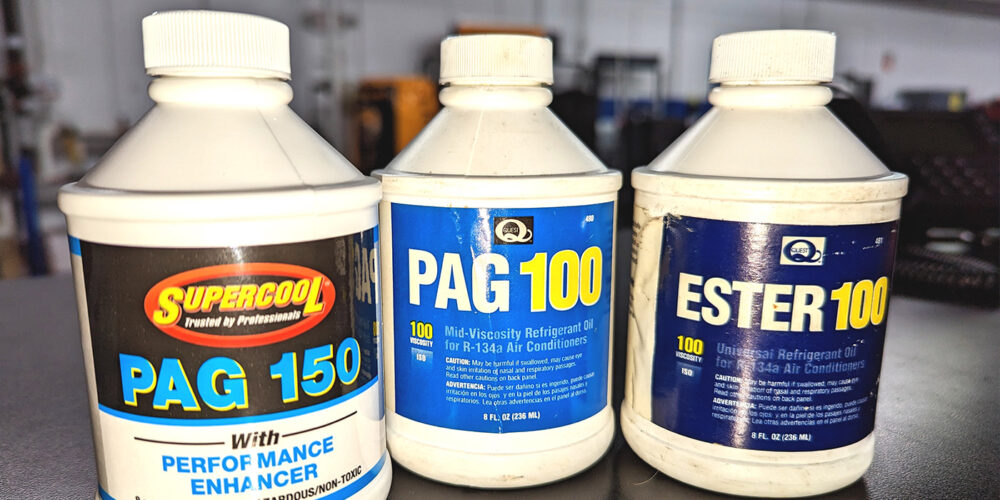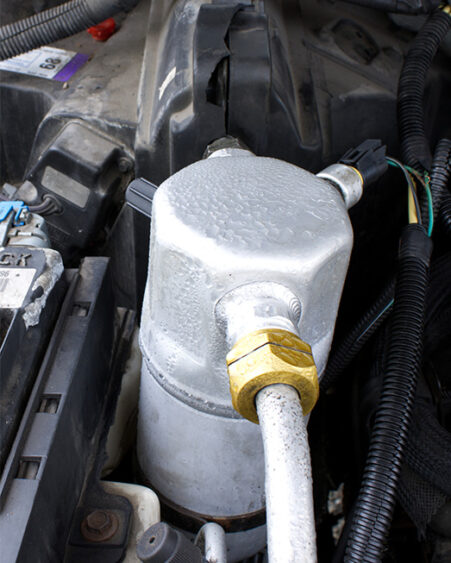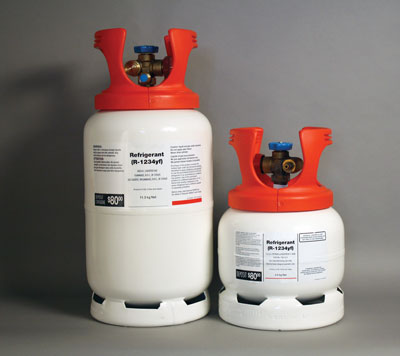Air conditioning (A/C) is like electricity. It can be one of the more difficult things to grasp because there’s a lot going on behind the scenes. The physical components are easy to understand; we can remove and replace them all day long. But just like electricity has resistance, voltage and current flow, A/C has temperature and pressure relationships and there’s a lot of science involved in the theoretical operation.
When we focus on the refrigerant oil itself, it’s had its share of misconceptions over the years and it didn’t help that A/C systems of old, i.e., R-12 systems, were a little more forgiving on the service side of things. But, you can throw that all out the window, and the only thing that matters now with today’s A/C systems, the oil, as well as the refrigerant capacities, leave no room for error.
Over the past 30 years, A/C has been continuously evolving. Different refrigerants aside, the most obvious change has been the volume of refrigerant which the systems require. It’s half, and in some cases less than half of what they used to be, meaning today’s systems must operate much more efficiently (that scientific stuff) in order to cool the same or better as they used to. The best part is, they do! They’re getting the job done with half the juice, but what about the oil capacity? It’s also approximately half of what it used to be.
Since the oil lubricates the compressor, is half enough? And, how does the oil charge affect the efficiency of the rest of the system? With most older compressors, only about 50% of the system oil capacity was present in the compressor at any point. It would naturally collect in the case, but they didn’t have a specific means to retain it, so it was picked up by the refrigerant and carried continuously around the system. Larger oil capacities ensured there was always enough to supply the compressor.
Modern compressors feature oil retention technology to keep more oil within the compressor case itself, and today’s compressors retain approximately 75% of the oil capacity of the system. When adequate oil is retained in the compressor, less is needed in the system, and the overall oil capacity is greatly reduced.
Reducing the amount of oil is one of the reasons that we have been able to achieve increased efficiency with less refrigerant. Oil creates a thermal lining on the surface of the evaporator and condenser, which reduces the heat exchange efficiency of the components. By reducing the amount of oil coating the inside surfaces, heat exchange efficiency is increased, so less refrigerant can be used to obtain the same result.
The accumulator connection: Orifice tube systems utilize an accumulator after the evaporator (as opposed to expansion valve systems that utilize a receiver/drier after the condenser). Since compressors are not able to compress liquid, the purpose of the accumulator is to capture any excess liquid refrigerant that exits the evaporator (a normal characteristic of orifice tube systems), and it also plays a critical role in compressor lubrication and cooling. Any liquid refrigerant and oil that enter the accumulator drops to the bottom. A tube inside the accumulator picks up the refrigerant vapor from the top, loops down to the bottom and back up to exit again from the top. At the base of this tube is a small orifice. The orifice allows the vapor to pick up small amounts of liquid refrigerant and oil that have collected at the bottom and carry it back to the compressor, replenishing the oil and providing additional cooling to the compressor.
This is critical because if a system is undercharged, there won’t be any excess liquid refrigerant exiting the evaporator. If no liquid refrigerant covers the base of the tube inside the accumulator, it won’t pick up the oil to return it to the compressor.
Sticking together: Refrigerant oil gets easily carried throughout the system in the liquid refrigerant, however a change in chemical state occurs when refrigerant evaporates. On old R-12 systems, the R-12 refrigerant and oil molecules had a strong attraction when evaporation occurred, so the oil would stick to the vapor molecules and get carried back to the compressor.
A big change that occurred starting with the R-134a systems, was that the refrigerant carries the oil along when in a liquid state, but when it evaporates, it doesn’t retain a strong bond with the oil. Some hangs on, but some doesn’t. As the refrigerant charge gets low over time, the liquid refrigerant in the evaporator also gets lower, and the oil tends to drop out and pool in the bottom of the evaporator. This causes a lack of lubrication at the compressor.
In addition to the lack of oil being carried back to the compressor, the refrigerant will also act as a solvent and strip oil from places it needs to be. For comparison, think of it loosely as a 2-stroke engine. The lubrication is carried in the air/fuel mixture. What happens to a 2-stroke when you accidentally grab the wrong can of gas? At minimum, we’ve all known someone who has done it.
In the case of an A/C compressor, a lack of proper lubrication will result in immediate wear and these particles and contaminants end up sticking to the oil, and, once again, if the system is low on refrigerant, the oil will eventually build up on the bottom of the evaporator. If not properly flushed, when the system is properly charged, the refrigerant will begin to pick up the oil and contaminants, and it’s a short path to the compressor.
With all that said, when replacing a compressor, your mindset should be to ask questions about the oil. Is this why it failed? Is there contaminated oil elsewhere in the system? How can I ensure the correct amount is put into the system?
The most critical factor when replacing a compressor is making sure the entire system is clean and free of contaminants and old oil. Most condensers today cannot be flushed. Nor can accumulators, driers, or anything with a desiccant material. All these components must be replaced, along with orifice tubes, including those which are crimped into a line. The remaining lines, hoses and the evaporator can be flushed, with the exception of lines that have a muffler in them.
All of these components can amount to a very expensive repair, and no one likes to break this type of news to a customer. But, this is reality. You can’t afford the comeback and your customer wants their A/C fixed right. How many people get their A/C fixed the week before a long summer vacation? If you install a new compressor but don’t do the necessary accompanying repairs it might be ice cold when it leaves the shop, and it might even be fine for a week.
But, do you want that angry call from your former customer when their vacation is interrupted and a shop in south Florida is telling them what they really need? It’s better to have them complain about the price but brag about the quality of your work.
So, you’ve got a system flushed and your installing new components. Where should you add the oil? If the compressor has a crankcase (indicated by the presence of a drain plug), you can add all the oil to the crankcase.
If there is no crankcase, follow these general rules: On orifice-tube systems, add half the oil charge to the suction port of the compressor, and the other half to the suction port of the accumulator. On expansion-valve systems, add half to the compressor suction port, and the other half to the evaporator.
The bottom line is, you don’t want a large volume of oil to get sucked into the compressor right away. It can do immediate damage, and after charging the system, always turn the compressor over by hand at least 10 full turns to remove any oil or liquid refrigerant that may be on a piston.
Oil type is just as important as oil capacity. To eliminate any possibility for error, use only the oil that is recommended by the vehicle manufacturer. Viscosity is very specific for different types of compressors, and refrigerant oils don’t mix well, period. This is yet another topic where science is heavily involved. And, with today’s EVs, oil has changed once again with oil that is non-conductive.
Modern A/C machines focus on accuracy, as well as refrigerant identification, and some have the option to flush the hoses to prevent any cross-contamination of refrigerant oil. While this originally came about as a means to prevent conductive oil from ending up in an electric compressor, it’s a great feature that can only benefit the health of any A/C system. TS














